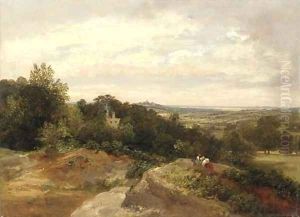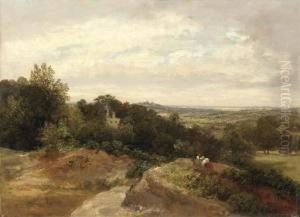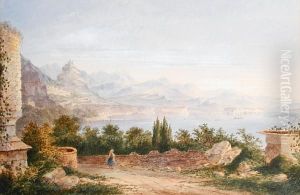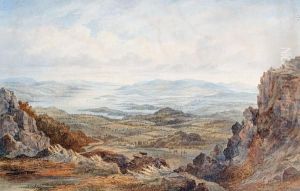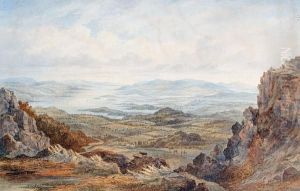Thomas Richard Hofland Paintings
Thomas Richard Hofland, born in 1777, was an English landscape painter who was active during the late 18th and early 19th centuries. Although not as widely recognized as some of his contemporaries, Hofland made notable contributions to the art of landscape painting in England during his lifetime. His work is characterized by its detailed and picturesque depictions of the English countryside and its serene portrayal of rural life.
Hofland was born in Worksop, Nottinghamshire, and was initially apprenticed to a mercer. However, he soon developed a keen interest in art and began painting. His early career was marked by a struggle to find a distinctive style and to gain recognition in the competitive art world of his time. Hofland was largely self-taught, which was not uncommon for artists of his era. He eventually moved to London, where he had greater access to patrons and could immerse himself in the vibrant artistic community of the capital.
Throughout his career, Hofland exhibited his work at prestigious institutions such as the Royal Academy and the British Institution. His paintings often depicted the landscapes of Derbyshire, Wales, and the Lake District, which were popular subjects for Romantic artists seeking to capture the sublime and idyllic aspects of nature. Hofland's landscapes were appreciated for their fine detail, realistic portrayal of natural elements, and the peaceful atmosphere they evoked.
Aside from his painting, Hofland was also an art teacher, and he published a book entitled 'The British Angler's Manual' which combined his love for fishing with his artistic skills, featuring illustrations of fish and angling scenery. Hofland's commitment to his craft and his role as an educator helped to influence a generation of younger artists.
Hofland's personal life was marked by his marriage to the successful novelist Barbara Hofland. Barbara was a prolific writer, and her literary success provided some financial stability for the couple, which was beneficial given the often precarious nature of an artist's income. The Hoflands were a well-known couple in literary and artistic circles, and their home became a meeting place for various figures of the day.
Thomas Richard Hofland continued to paint and exhibit his works until his death in 1843. While he may not have achieved the enduring fame of some of his peers, his landscapes continue to be appreciated for their beauty and tranquility. They represent a significant contribution to the English landscape tradition and offer a window into the aesthetic values and cultural aspirations of his time.
